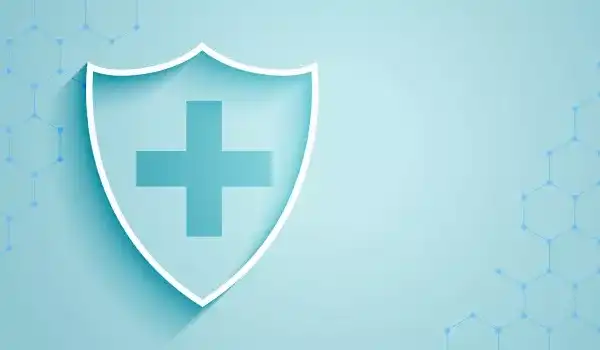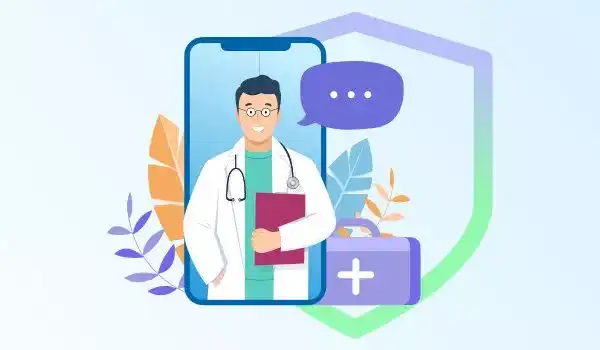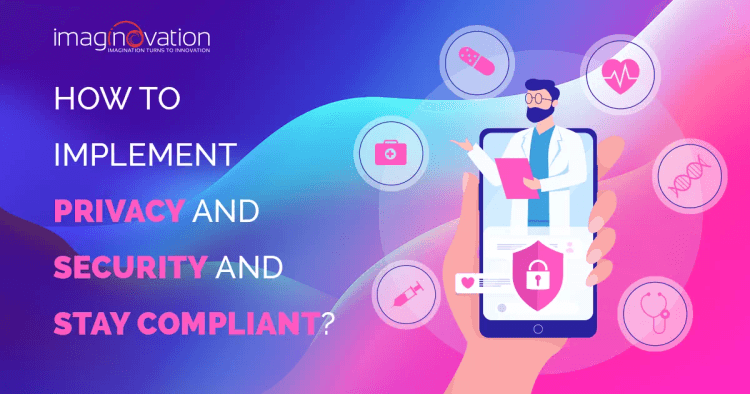Mobile health applications are consistently on the rise. According to studies, the mhealth apps market in the United States will reach 50 billion dollars by 2025.
The mobile health market is flourishing. It is because of the utmost convenience that mobile health apps offer to patients & healthcare professionals alike.
However, as healthcare organizations turn to mobile app development to improve their patients’ outcomes, they witness an increased demand for data security and privacy.
Why?
It’s because mHealth apps collect critical health data. Therefore healthcare app developers need to implement certain security measures to ensure data security.
So, are you aware of the risks associated with mhealth apps and how to mitigate them?
This blog will discuss mhealth apps’ data security challenges and the steps needed to improve their security.
Security and Privacy Issues Associated with mHealth Apps

Mobile apps aim to make healthcare more accessible and affordable for people.
However, these apps have their own downsides when it comes to security. Let’s see some common security and privacy challenges faced by mHealth applications:
1. Data Sharing and Consent Management
Most mHealth apps gather data about people’s (user, in this case) behavior, physiology, physical activity, and other similar details. These details are later used for evaluation and analysis by care providers.
This may sound essential, but it also raises the question of consent – Consent from the user. Consent about whether, when and, with whom data will be shared.
Without apt consent management, data sharing by these applications is a risky business.
2. Access Authentication
User Identification in the mHealth app is critical. It helps grant access to the app and its data to the correct person.
It is quite common for many of today’s mHealth apps to be based on the smartphone. App uses the device’s user interface to gather, process, and report health-specific information about the user.
Since smartphones are considered personal devices, you may safely assume that the user is indeed the owner. But not when the smartphone is stolen or borrowed.
It can result in disastrous situations – the phone’s mHealth apps may start storing data about the wrong person or start exposing the patient’s PHI via app notifications.
This is undoubtedly risky.
3. Confidentiality and Anonymity
Most of the information stored and processed through mHealth apps is highly personal and sensitive. Therefore the data stored must remain confidential, subject to access control, and anonymous.
In reality, the confidentiality and anonymity of an app’s data are prone to threats by various attackers.
4. Threats by Mobile Devices
Mobile devices are vulnerable to unauthorized usage or physical theft in case they are left unattended.
When these devices have the mHealth app installed, it could lead to the disclosure of sensitive and personal health information.
5. Malware Infections
Malicious attacks from cybercriminals exploit the vulnerability in a mHealth app. It can also use social engineering techniques to trick the user and install itself on a mobile device.
The installed malicious software obtains sensitive health information stored on the device, alters it, and sends it to an untrusted user.
How to Build A Secure and Compliant mHealth App?

While sources of your mHealth application’s security threats and privacy concerns could be anything, it is imperative to build a secure and compliant mHealth app.
We’ll tell you how to do it:
1. Research for the Compliance
Technological advancements continue to influence the medical and healthcare industry. But this doesn’t mean it is not bound by any regulation. There are various government and legal bodies for such regulations.
Why?
There are numerous laws and policies that regulate how a Healthcare provider must handle sensitive patient data.
Such laws and policies ensure there is no misuse.
Your mHealth app may fall under a specific compliance standard and regulation because of many reasons. It may be due to the demands of your app’s functionality, the region it’s used in, and the kind of data it is transmitting or storing.
Make sure you invest sufficient time to explore if your app needs compliance with any specific regulations.
How do you decide if your mhealth app requires compliance and regulation?
Suppose your app is expected to be used by different healthcare personnel and is also expected to save or transmit sensitive data. In that case, there are strong chances of it being the right fit for policy compliance.
Do note that these policies will differ from region to region and the type of data it manages.
Let me tell you what kind of data is at risk and needs protection.
Sensitive data that need protection include any / all of the following:
- Insurance-specific information.
- Patient’s data – social security numbers or contact info.
- Medical histories.
- Prescription history.
- Any other sensitive information.
Let’s go through the most common regulations and compliance acts that must be taken into consideration while building a mHealth app:
HIPPA
HIPPA stands for the Health Insurance Portability and Accountability Act. Any mHealth application or software used in wearables for the US market that stores and transmits protected data must comply with HIPAA. This Act:
- Helps to protect sensitive patient data.
- Regulates the way data is shared.
- Limits access to information to anyone who isn’t authorized.
GDPR
GDPR is General Data Protection Regulation. It is one of the strictest privacy and security laws in the world. It refers to a set of regulations for companies that collect and transmit EU user data on the Internet. To build a health app for the European market, you must follow GDPR requirements.
HL7
Health Level Seven standard defines the format for the exchange of any health-related information.
2. Ensure Proper Encryption
Trust is an essential aspect between app users and publishers.
If the patients (app users, in this case) doubt their eHealth information’s confidentiality, do you think they will share any important details with the app (health providers, in this case)?
No. They will most certainly withhold all relevant information from their healthcare providers. In turn, health providers, too, won’t be able to trust that the information they’ve received via the app is complete.
This situation will make it challenging to provide adequate care.
Not only that, health care providers must prioritize protecting themselves from any legal ramifications of breaching patient privacy, knowingly or unknowingly.
So, without ensuring the safety of your app, the whole mHealth system becomes useless.
Then what’s the solution?
Encrypting sensitive patient information is the best solution in this case. To solve the problem of trust, developers and app publishers must encrypt sensitive data. Healthcare encryption standards are considered an effective way to protect sensitive data, whether at rest or in transit.
Encryption can help you protect:
- The databases,
- Files stored on the server,
- Communication channels,
- E-mail messages,
- And other potentially sensitive data.
What is encryption?
The encryption process uses algorithms to turn information written in plain text into an unreadable, jumbled code.
This unreadable code is known as ciphertext. It needs an encryption key to decrypt and turn the jumbled code back into readable plain text. The encryption key is accessed only by the authorized parties (healthcare providers and patients, in this case).
This means that even if somebody steals the information from the company or user, they won’t be able to use data while encrypted.
It is done to ensure the security of a mobile medical application.
You must use special protocols – Secure Socket Layer (SSL) and Transport Layer Security (TLS) for data encryption to ensure complete information privacy.
3. Implement User Authentication
MFA (Multi-Factor Authentication) is a way by which any mHealth app is protected from unauthorized use.
This method grants entry to app users only when they successfully present separate evidence that proves they are indeed authorized to access the app. MFA is especially beneficial if a user’s device is stolen or lost, preventing unauthorized access to their private information.
MFA uses a password and an additional component – like a fingerprint, voice identification, retinal scanning, or a one-time-password to verify the user’s identification.
As the name suggests, multi-factor authentication has multiple ways to authenticate a user. It is not easy to decide which method is the most suitable for a mHealth app. Every method has some advantages and disadvantages. Therefore, it is best to analyze aspects like your app’s functionality or usability to ensure you use the most appropriate authentication method and ensure data privacy and protection.
4. Conduct Security Testing
What happens if you do not conduct comprehensive testing of your mHealth app?
You can easily ruin the reputation of your company and your app.
Testing is not only quality assurance testing; it is also the security testing of your app.
Why are security tests necessary?
Security tests exploit the vulnerabilities that may not be very apparent. These vulnerabilities exist in the app’s operating systems and services, application flaws, or even risky end-user behavior.
It would help if you looked out for the following mobile security vulnerabilities in your newly built app:
- Unintended Data Leakage This happens when your app is found to leak sensitive data that may be accessible to other apps on the user’s device or to an attacker who has access to the device.
- Poor Authorization and Authentication Your app may have poorly implemented authorization which can be easily bypassed.
- Insecure Data Storage Your app may be storing sensitive data with insecure file permissions or with insecure encoding, thus making it accessible to unauthorized users.
- Broken Cryptography Your app may be using insecure encryption algorithms, which may not be enough to protect the kind of sensitive data it stores.
- Improper Session Handling Apps are often known to store cookies, and other authentication information on the device for however long a session may be open. If your app fails to do this securely, it may result in an attacker taking over the user’s session.
5. Protect your app from all kind of attackers and penetration
It’s not only the healthcare techniques that have become more advanced. It’s also the techniques of hackers and malicious attackers that are improving day by day.
What are these attackers after? What do they want?
These attackers are after the sensitive data because it can be sold back for a significant amount.
It is no exaggeration to say your mHealth app’s sensitive data is under threat from many different attacks and attackers. That’s why it’s essential to know how to secure and protect your app from such threats.
There are attackers known as hackers who infiltrate protected systems and get hold of otherwise private information. There is yet another form of attackers, who are known as social engineers.
They exploit the app users’ human weakness to gain access to their information of login credentials or account information of the users.
It is known as ‘phishing.’ Man-in-the-middle (MITM) attack consists of a third party eavesdropping (intercepting the communications between two parties – mHealth app and a database with protected health information).
Build A Winning Healthcare App with Imaginovation
mHealth apps address a unique healthcare need. It allows both patients and healthcare providers to connect conveniently and securely.
However, trust among users being the first step towards facilitating adoption by new users. If you’re looking to build a winning healthcare app that’s secure and trustworthy, get in touch with us.
We are an award-winning web and mobile app development company with vast experience in building robust and secure mobile apps for different industries.
Let’s talk.




